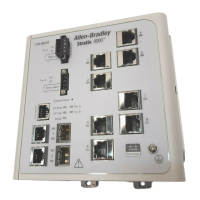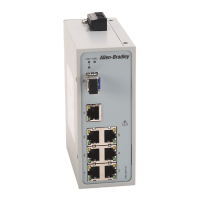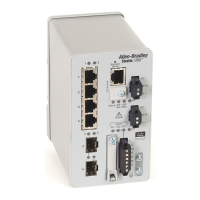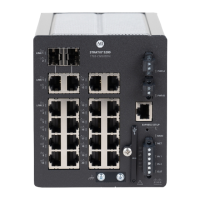48 Rockwell Automation Publication 1783-UM003G-EN-P - December 2012
Chapter 2 Switch Software Features
Switch A is in VLAN 10, and Switch B is in VLAN 20. The Layer 3 switch has an
interface in each VLAN.
When Host A in VLAN 10 needs to communicate with Host B in VLAN 10, it
sends a packet addressed to that host. Switch A forwards the packet directly to
Host B, without sending it to the Layer 3 switch.
When Host A sends a packet to Host C in VLAN 20, Switch A forwards the
packet to the Layer 3 switch, which receives the traffic on the VLAN 10 interface.
The Layer 3 switch checks the routing table, finds the correct outgoing interface,
and forwards the packet on the VLAN 20 interface to Switch B. Switch B receives
the packet and forwards it to Host C.
Types of Routing
Stratix 8300 switches can route packets by using these methods.
Routing
Feature Description
Static routing Static routing forwards packets from predetermined ports through a single path into and out of a
network. Static routing is secure and uses little bandwidth, but does not automatically respond to
changes in the network. Static routing is manually configured by the user for each path in the
system.
Dynamic routing Dynamic routing protocols are used by Layer 3 switches to dynamically calculate the best route for
forwarding traffic. There are two types of dynamic routing protocols:
• Distance-vector protocols
• Link-state protocols
Layer 3 switches using distance-vector protocols maintain routing tables with distance values of
networked resources, and periodically pass these tables to their neighbors. Distance-vector
protocols use one or a series of metrics for calculating the best routes. These protocols are easy to
configure and use.
Distance-vector protocols supported by the switch are Routing Information Protocol (RIP), which
uses a single distance metric (cost) to determine the best path and Border Gateway Protocol (BGP),
which adds a path vector mechanism. The switch also supports the Open Shortest Path First (OSPF)
link-state protocol and Enhanced IGRP (EIGRP), which adds some link-state routing features to
traditional Interior Gateway Routing Protocol (IGRP) to improve efficiency.
Routers using link-state protocols maintain a complex database of network topology, based on the
exchange of link-state advertisements (LSAs) between routers. LSAs are triggered by an event in the
network, which speeds up the convergence time or time required to respond to these changes. Link-
state protocols respond quickly to topology changes, but require greater bandwidth and more
resources than distance-vector protocols
Unicast routing Unicast routing is used for all network processes where a private or unique resource is requested.

